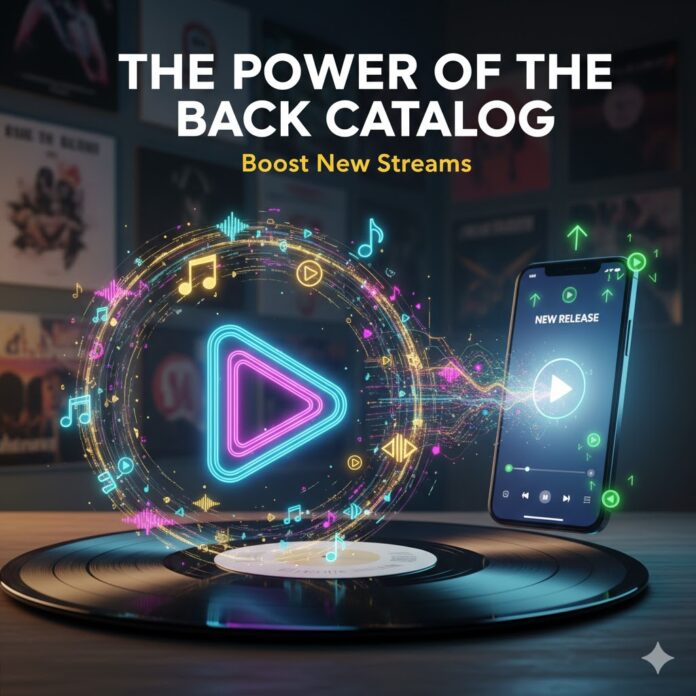
In the hyper-competitive world of music streaming, the buzz around your new release can fade quickly. But what if the key to long-term success—and a huge boost for your next single—is already hiding in plain sight? It’s your back catalog.
Smart artists understand that their older music isn’t just history; it’s an untapped goldmine of algorithmic activity, new listener discovery, and a vital revenue stream. By implementing strategic re-packaging and re-marketing, you can keep your entire discography active and drive listeners directly to your latest tracks.
Here is your comprehensive guide to re-igniting your back catalog and making it work for your future success.
🎧 1. Repackaging: Give Old Tracks a Fresh Look
The streaming algorithm loves activity, but a decade-old track buried in an album can feel like a forgotten relic. Re-introducing it with a new angle is the first step to securing those coveted algorithmic placements.
- Acoustic & Live Versions: Release stripped-down or live-performance versions of fan-favorite back catalog tracks. These fresh UPCs (universal product codes) and audio masters show up as “new” releases, driving traffic and streams that often spill over to the original.
- The Remix/Collaboration Treatment: Partner with another artist, a producer in a different genre, or a DJ for an official remix. This introduces your old song to a completely new audience and their followers, effectively cross-pollinating your fan bases.
- Anniversary Editions & Demos: Celebrate key album birthdays (1, 5, 10 years) with special, limited-time releases of B-sides, demos, or a director’s-cut version. This creates a compelling press story and gives fans a reason to dive back into the full original album.
📈 2. Algorithmic Activity: Leveraging Data for Discovery
The major streaming platforms’ algorithms (Spotify’s Discovery Mode, Release Radar, etc.) are built on user engagement. Your older tracks have a track record; it’s time to use that data.
- Targeted Advertising: Use data from Spotify for Artists and other insights to see who is still listening to your old tracks (age, geography, other artists they listen to). Run very targeted ads (Meta Ads, TikTok Ads) using snippets of those specific songs, aimed precisely at that high-conversion audience.
- SEO Tip: Use ad copy that highlights the song’s past success, e.g., “The fan-favorite track from the ‘Future Sounds’ album, now with a new remix!”
- Curated Playlists: Create and actively promote your own thematic playlists on Spotify, Apple Music, and YouTube. Group your back catalog by mood, theme, or collaborators (“Songs for a Rainy Day,” “Early 2000s Throwbacks”). Always place your new release as the first or second track to ensure immediate exposure.
- Update Metadata: Go back and ensure the metadata (genre tags, sub-genres, moods) for your older tracks are optimized and consistent with your current sound, making them easier for algorithmic and user-created playlists to find.
🎥 3. Content Creation: Stories and Snippets for Social Virality
The rise of short-form video on TikTok and Instagram Reels offers the perfect platform to re-contextualize old music. The algorithm loves fresh video content, even for an old song.
- “Story Behind the Song” Series: People love nostalgia and authenticity. Create a recurring social media series where you share the anecdote, inspiration, or behind-the-scenes moments from when a specific back catalog song was written or recorded. Use the song as the background audio!
- Short-Form Video Snippets: Turn the most viral-worthy 15-second hooks from your back catalog into visualizers or simple performance clips. Use trending hashtags in your niche. The goal is to get the track used by content creators, driving its audio up the platform’s trending lists.
- Lyrics and Visuals: Upload official lyric videos or updated, high-quality visualizers for popular deep cuts to YouTube. This captures massive search traffic from users looking for song lyrics and gives your content a new life in a fresh format.
🎯 The Ultimate Goal: Using Old Streams to Fuel the New
The real power of a thriving back catalog is the algorithmic momentum it builds for your new music.
When listeners discover an older track and then navigate to your artist profile, the streaming platform sees this as a strong signal of artist affinity. This user is more likely to be served your new release in their Release Radar, Discover Weekly, or personalized radio mix. Every time an old song is added to a playlist, it increases your profile’s algorithmic weight.
Don’t let your history gather dust. By strategically re-packaging, optimizing your data, and creating fresh content, your back catalog can be the ultimate engine, consistently boosting your visibility, diversifying your income, and ensuring your next single lands with maximum impact.
























 🔥 Limited Time: Get 55% OFF All Plans - Ends in:
🔥 Limited Time: Get 55% OFF All Plans - Ends in: